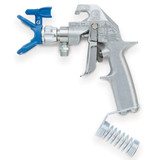Description
Contractor Airless Gun Repair Kit - 218070
Used to replace the needle and internal packing's of an airless spray gun.
For use to repair these Airless Spray Guns
- 243285 - FTX Gun with RAC V
- 238350 - FTX Gun with RAC IV
- 238352 - Contractor ST Gun
- 243282 - Contractor Gun with RAC V
- 824950 - Contractor Gun with RAC V (SW Model)
- 220955 - Contractor Gun with RAC IV
- 244161 - Contractor In-Line Valve Gun
Details
Stand: |
No |
Manufacturer: |
NorthStar Parts |
Part: |
Yes |







